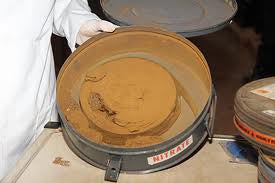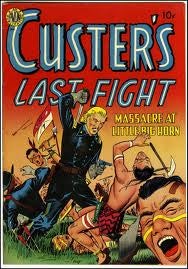At last week’s Association of Moving Image Archivists conference in Richmond, VA., the Nitrate Committee chaired a panel, which presented some research on nitrate flammability, done at the University of Wisconsin–Madison, by the Wisconsin Historical Society, the Wisconsin Center for Film and Theater Research, and funded by the National Endowment for the Humanities.
One of the most surprising finds, presented by Heather Heckman, Katie Mullen, and Mary Huelsbeck, is that nitrate may become less flammable, as it decomposes, not more flammable, as we have all thought for years. Indeed, it was not possible to ignite through friction or impact, once nitrate film had turned to a brown powder. The quality of the burn also appeared to change, depending on the stage of decomposition. Listening to the panel of experts, I was reminded of some of the weird places I have found nitrate film during my career.
 In 1991, when I was Senior Curator of the Film Department at George Eastman House, I got a call one day from a gentleman who lived in Elmira, New York, about sixty miles south of Rochester, asking me whether I was interested in some old film. Being used to receiving several such calls a week from individuals who happen to find an 8mm Chaplin film in their closet, I was not yet interested, but then the gentleman said the films were about two inches wide and had no sound. That could only mean 35mm and silent, so I made a date to drive down to look at the collection.
In 1991, when I was Senior Curator of the Film Department at George Eastman House, I got a call one day from a gentleman who lived in Elmira, New York, about sixty miles south of Rochester, asking me whether I was interested in some old film. Being used to receiving several such calls a week from individuals who happen to find an 8mm Chaplin film in their closet, I was not yet interested, but then the gentleman said the films were about two inches wide and had no sound. That could only mean 35mm and silent, so I made a date to drive down to look at the collection.
 When I got to Elmira a few weeks later, I found a modest cottage in a street of equally neat little houses and gardens. The gentleman and his wife invited me in and proceeded to tell me that the films had belonged to his brother-in-law who had been slightly “cracked.” The said party had been vaguely involved at the extreme fringes of some sort of show business, and for years he had schlepped around this “trash,” along with a hand-cranked, portable projector. He would screen the films without an audience for his own enjoyment.
When I got to Elmira a few weeks later, I found a modest cottage in a street of equally neat little houses and gardens. The gentleman and his wife invited me in and proceeded to tell me that the films had belonged to his brother-in-law who had been slightly “cracked.” The said party had been vaguely involved at the extreme fringes of some sort of show business, and for years he had schlepped around this “trash,” along with a hand-cranked, portable projector. He would screen the films without an audience for his own enjoyment.
Since the man in question had passed away several years before, the films and projector had been sitting in the basement, but now this gentleman was himself retiring and moving to Florida, which meant the stuff had to go. I got the distinct feeling that Mr. Elmira had not gotten along well with his wife’s brother. Only then did he take me into the basement, where the nitrate cans were neatly stacked up against the oil-burning furnace. I told the gentleman that he was lucky he hadn’t blow himself, his wife, his dog, and his house to Kingdom Come. Back in Rochester, where we were able to identify almost all of the ninety some reels, finding many unique, tinted prints by such today unknown, low budget companies as Tiffany, Aywon, and Powers.
 That such collectors were not unique to the United States became clear to me several years later, when I was Director of the Munich Filmmuseum. In 1996, I was contacted by the German film director, Michael Verhoeven, whose production assistant had pulled two 35mm projectors out of the basement of an abandoned cottage in the center of Munich. He told me there was also a sizable collection of films in the basement. When we went to take a look, we found a little cinema with ten theater chairs, an electric generator, and a projection booth.
That such collectors were not unique to the United States became clear to me several years later, when I was Director of the Munich Filmmuseum. In 1996, I was contacted by the German film director, Michael Verhoeven, whose production assistant had pulled two 35mm projectors out of the basement of an abandoned cottage in the center of Munich. He told me there was also a sizable collection of films in the basement. When we went to take a look, we found a little cinema with ten theater chairs, an electric generator, and a projection booth.
The house had apparently belonged to an electrical engineer who worked as a city inspector. With his generator he was able to screen films, even in the midst of the war, when electricity was rationed. Unfortunately, the basement was very damp, so that all the acetate films stored there were totally eaten away by mold. Not one of them could be saved. In a little shed behind the cottage, however, we found a cache of over fifty films, mostly produced by local Bavarian companies that had long since ceased to exist. Like the Elmira films, there was virtually no decomposition, and they have now been preserved.
Did the oil protect the films from moisture, which is the major factor in decomposition? Who knows?
Finally, in 2010, my staff at the Archive got a call from a family up in Oregon, where the pater familias had passed away more than a decade ago and left a sizable collection of more than fifty nitrate films. The gentleman had been some kind of projectionist and decided to protect the films by packing them in barrels with machine oil. Our nitrate team, headed by Rosa Gaiarsa, drove up to Oregon and brought the films down to Los Angeles. With the help of the Film Technology Company we began cleaning the oil off every single reel, a massive job that has taken several years, because the oil had to be removed by hand from each reel, winding through the film, and then machine cleaned.
Amazingly, virtually zero of the films have shown any serious sign of decomposition. Did the oil protect the films from moisture, which is the major factor in decomposition? Who knows? The Esau Collection includes forty features, mostly from the 1920s, of which half are complete and at least twelve appear to be unique, including a 1923 German version of A Mid-Summer Night’s Dream, oodles of B westerns, and a virtually complete silent serial, The Hand of Vengeance. There are also over 60 shorts, the majority of which also seem to be unique.
In any case, thirty years after our field started its “Nitrate Can’t Wait,” campaign, we are finding that nitrate can wait for preservation or digitization, if properly stored, just not in oil, please.






 Mobile Navigation
Mobile Navigation


Comments